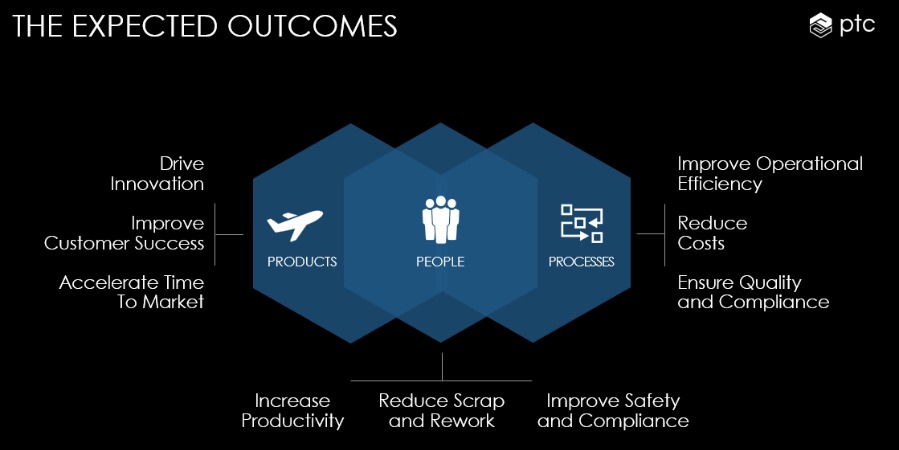
The term digital transformation has been around for awhile – and, truth be told, it has many different meanings and interpretations, depending on its application and industry. However, we do hear many fallacies about the term and its potential that are universal.
This blog post is devoted to debunking the most commonly held digital transformation myths and misconceptions. With a clearer understanding of what digital transformation means – and what it doesn’t – industrial companies are in a better position to executing on it. Let’s jump in:
We’re putting this one first because it’s often the first hurdle businesses need to overcome. Many companies are dissuaded from digital transformation because they can’t define it or feel it’s too complex, it means different things to different people.
It boils down to this: Digital transformation helps companies to address critical business challenges created by the convergence of the physical, digital, and human worlds. It’s a broad business strategy, applicable across all industries, designed to solve business problems (both big and small) and unlock new opportunities through the use of technology.
Here’s another way to think about it. For centuries, humans lived and worked without digital technologies and now, in the span of a few decades, digital has become an essential part of our world. At this crossroads, there is friction. Many companies struggle with integrating their long-standing processes and legacy machines with newer, digital ways of doing business.
More than digitization, digital transformation represents a cultural shift in how companies get work done, engage with customers, design and manufacture products…and on and on. Physical things are now connected, talking to each other, and able to communicate data about their work and their environment. The digital world in many ways is a mirror image of the physical things – its twin. With digital systems, the data provided by physical things is put in context and able to be further analyzed and simulated.
Digital transformation is an encompassing term that represents opportunity, especially for industrial companies. It takes on many iterations and is unique to each business, but there is transformative power in creating more seamless interactions between the physical and digital worlds.
This one drives me crazy as there’s so much research out there and examples of digital transformation initiatives reducing costs, improving quality, and uncovering opportunities for differentiation and new revenue streams.
The benefits of digital transformation are real – and companies that are not actively executing on a digital transformation strategy are falling behind competitors that are. Understanding the potential value digital transformation can have is a realistic starting place for many industrial companies.
Here’s a glance at some of the results possible for industrial enterprises:
Metrics have been compiled from CIMData, Aberdeen Group, Gartner Group, IDC, and PTC customers.
Digital transformation outcomes are possible in three critical areas: products, processes, and people. Check out this graphic breaking down how we’ve seen DX initiatives make an impact:

Digital transformation undoubtedly involves technology, but they are only tools, or levers, to unlock a greater goal. A DX strategy should begin and end with identified business value.
A recent survey found that lack of understanding of technologies available to support digital transformation projects is the main cause of failure for 51% of firms polled.
One other crucial point is digitization does not equal digital transformation. Implementing new technology is not transformative unless it’s accompanied by cultural, process, and customer-centric initiatives. In other words, don’t pursue technology for technology’s sake.
Furthermore, digital transformation is very rarely, if ever, a single technology, multiple technologies need to work together to achieve business-critical objectives.
This ones for the naysayers out there – for those leaders who don’t believe they have much to gain for going through the trouble, expense, and challenge of digital transformation.
As we shared above, enterprises are seeing real results from digital transformation – and as a result of initial successes have quickly moved beyond proof-of-concept (POC) projects. When projects are too ambitious, or ambiguous, the result is often failure. In a McKinsey survey of over 1,700 business executives, only 14 percent said digital transformation efforts have sustained performance improvements, with only 3 percent reporting complete success at sustaining change.
However, we’ve seen a pattern emerging from these failed initiatives – a lack of vision and short- and long-term strategy.
A strategic approach – with clear ROI goals tied to a clear business value proposition – is the groundwork for digital transformation success. The POC initiative should be chosen with considerable thought and should be developed with a full vision and roadmap in mind, yet success needs to be measurable in a realistic way. With a step-by-step approach, businesses can build on each success, learn from mistakes, and scale quickly.
For example, Polaris, a global leader in snowmobiles and all-terrain vehicles, started its digital transformation with the implementation of a product lifecycle management (PLM) software and the establishment of a digital thread. With PLM as the foundation, they are expanding how they leverage that data with IIoT and augmented reality.
The last myth is the one we most emphatically argue against. Digital transformation is an imperative for industrial companies, if they want to be in business in a decade.
Harnessing the power of technology to advance processes, improve products, and empower the workforce is what digital transformation is all about. With a clear vision and strategy, it opens up opportunities to create new business models and streamlines operations.

Nicholas Leeder serves as Vice President, Head of Digital Transformation Group, at PTC. He has a passion for helping companies capitalize on digital transformation and Industry 4.0 and realize measurable results and business value. As one of the leading thought leaders and advisers in Europe around the digital changes in engineering and operations, he shares his practical business and technology experience developed from over 20 years of assisting companies gain the maximum value from these transformations.
©Copyright 2025. All rights reserved by Modelcam Technologies Private Limited PUNE.